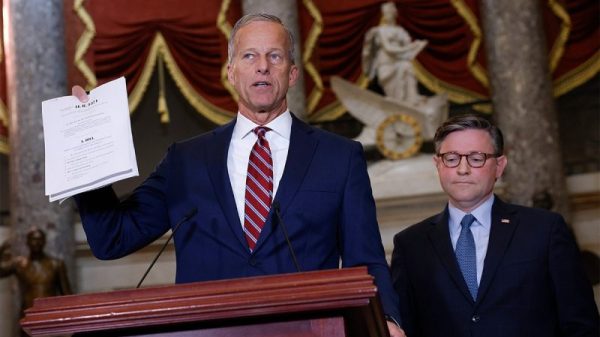After the most recent Supreme Court session, in which President Biden didn’t like some of its rulings, as with denying him the unilateral power to forgive student loans as a violation of the constitutional separation of powers, he said, “this is not a normal court,” not just conservative, but rather “like a throwback, some of the decisions that they’re making,” which has “done more to unravel basic rights and basic decisions than any court in recent history.”
Biden’s character assassination of the current Supreme Court echoed Justice Kagan’s student loan case dissent: “In every respect, the Court today exceeds its proper, limited role in our Nation’s governance,” but instead, “From the first page to the last, today’s opinion departs from the demands of judicial restraint.”
Such accusations of the Supreme Court’s failing to exercise appropriate judicial restraint, however, bypass a crucial question: What kind of judicial restraint are we talking about?
Restraint means “to keep someone or something under control,” but it does not identify who the relevant someone is. And that opens the door to serious confusion on this issue, of which Jonah Goldberg said, “judicial restraint is now seen as judicial activism.”
The key to this kerfuffle is whether the appropriate restraint involved is that the Supreme Court is to restrain itself from “interference” with what other branches want to do or whether government’s overstepping of its constitutional authority is to be restrained, and it is the Supreme Court’s job to do the restraining. It is also the key to similar confusion in terms of judicial activism, since it is not whether the Court is to be active, but which principles will inform its activity, that is the crux of the matter. In fact, Supreme Court activism that constrains government powers in deference to constitutional protections mirrors our Founders’ views.
I don’t know of anyone that said this more clearly than Alexander Hamilton in Federalist 78, America’s most famous statement of the intended role of our judiciary:
A limited Constitution…can be preserved in practice no other way than through the medium of courts of justice, whose duty it must be to declare all acts contrary to the manifest tenor of the Constitution void. Without this, all the reservations of particular rights or privileges would amount to nothing.
Explaining how this is to be carried out, Hamilton concludes:
Whenever a particular statute contravenes the Constitution, it will be the duty of the judicial tribunals to adhere to the latter…to guard the Constitution and the rights of individuals.
While that reference to legislation does not directly refer to President Biden’s executive branch decisions, the principle surely applies to executive actions authorized under the Constitution as well. In fact, it applies even more to his executive actions than legislation in areas where he is not granted the power to do what only Congress is allowed to do.
Federalist 78 asserts that courts are not to invalidate laws consistent with the Constitution, and that is the restraint the courts are to exercise for themselves. But not every law is constitutional just because it passed Congress, and not every executive decision is constitutional just because it was issued. So while courts are to exercise the above restraint, they are also to actively strike down what is inconsistent with the Constitution. That is the means of imposing restraint on other branches’ overstepping.
In other words, Federalist 78, defines the Court’s proper role as neither an active subverter of citizen’s rights nor a passive accomplice in subversions by others in government. It is to be a very active rather than a hyper-restrained guardian of the constitutional rights of citizens.
That leads to another question: Why have liberals and progressives redefined discussion away from the real issues of restraint and activism to ad hominem attacks (which are logical fallacies, not logical arguments) on the current court?
It is because a court that takes seriously the Constitution as the highest law of the land is necessarily at odds with those who insist it is a “living document.” When the meaning of the Constitution can easily be altered by judicial interpretations, those interpretations supplant the highest law of the land in practice. And since such “living document” rulings have been attacked as judicial activism rather than restraint, using the same language, along with adamant insistence on stare decisis (to stand by things decided) to attack rulings that threaten to undo that constitutional revisionism allows them to confuse Americans into the conclusion that defending the Constitution is unprincipled.
A court actively defending the Constitution threatens precedents that liberal courts have used to create new rights out of thin air (or from “emanations from penumbras” around stated rights) or that have twisted words to do serious violence to the meaning of the Constitution–words like “taking” in the 5th Amendment, “commerce” in Article 1, and even “no” and “not” in the Bill of Rights, or phrases like “waters of the United States” more recently. But those who have effectively remade the Constitution, while bypassing the process established to do so legitimately, are determined to defend those precedents.
In fact, the approach used in several cases in the recently concluded term threatens the pattern of Supreme Court activity since the 1930s. Liberal or progressive courts create new rights or redefine existing ones, expanding government powers or eroding freedoms from government control. But to prevent those constitutional deviations from being overturned, they then insist that conservative courts must leave them in place and build upon them, out of deference to those “new and improved” precedents. The result has been the ongoing erosion of Americans’ rights.
Of course, if the Supreme Court must defer to earlier precedents, there is no respectable argument for the creative interpretations (such as from the New Deal and Warren courts) liberals and progressive are now so desperate to defend, since they clearly deviated from constitutional precedent.
The Supreme Court’s recent rulings that are subject to the most intense current attacks did not ignore precedents, as those insisting they are violations of judicial restraint or commissions of inappropriate judicial “activism” allege. Instead, they are faithful to the Constitution and the limited authority it delegated to government as the controlling precedent. But that requires overturning laws and interpretations inconsistent with the Constitution, to reinstate the rights and protections that have been undermined. If such court “activism” is to be rejected in favor of judicial “restraint” that enables violations of the Constitution, much of it is already a dead letter, and it has become what James Madison called a mere “parchment barrier” that fails to protect our rights in fact.




































